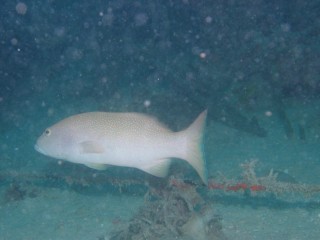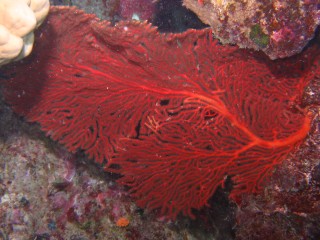
Although the fish shows up clearly,
backscatter fills the rest of the photo.
Click on the image to see this even better
|
Underwater Pages UW Photo Pages |
Backscatter
by Chris Hacking
 Although the fish shows up clearly, backscatter fills the rest of the photo. Click on the image to see this even better |
Backscatter is one of the largest obstacles to great underwater photography. Since ambient light is very limited underwater, strobes are used far more underwater than on the surface. However, even beautifully clear water usually contains particles big enough to show in the photo, and a few small, bright spots can do amazing damage to the quality of a picture, especially if they are in bad places (like over a fish's eye).
Backscatter only shows up when the flash fires, so there is effectively no way to tell, before taking the picture, how it will come out. Digital shots may even appear good on the tiny and low-resolution built-in screen, but when viewed on a computer or printed, a scattering of bright dots can show up to wreck the image. Although high-quality image software can theoretically edit out such things, backscatter often damages a picture enough to make it not really reparable, or at least not worth the time.
 This photo has many points of backscatter, but they are hardly visible because they are within the field of focus. (Click on the image to see them better) |
However, there are certain ways to anticipate backscatter, indicating when taking a picture isn't worthwhile. Any shot with a flash has a potential risk, but the risk increases with wide angles, murky water, long range, and visible sediment. Sediment is an obvious problem; anything large enough to be seen with the naked eye in normal light will be a big, bright, burned out spot on a flash photograph. Long range and wide angle shots are both issues because of the great volume of water to contain particles, either directly between camera and subject or generally around a large subject. Murky water is generally the best indicator, at the start of a trip, of whether backscatter will be a constant issue. In general, backscatter will be an issue for shots taken in water with less than 50' (15m) visibility at the surface. Note that this is certainly not any sort of concrete number; it is related to my equipment and the tropical Pacific waters I shot in. Even then, there are no hard and fast rules, each dive will be a little different.
On my dives, I try to take photos as close as possible to my target, which can allow a target to show clearly even if there is a lot of backscatter behind and around it. Such pictures can be cropped if necessary, removing most of the backscatter while leaving a large and high-quality photograph of the intended target. The damaging effect of backscatter can also be minimized by using a high f-stop (narrow aperture) to allow lots of depth of field. This means that individual points of backscatter are more likely to appear as a single sharp dot rather than a large, out-of-focus splotch. Although the dots are brighter, they are often less noticeable and are much easier to edit out. The target is also more likely to be crisply focused. Tight apertures need lots of light, but that is why you're using a flash in the first place.
Top Level: Home | Destinations | Cruising Info | Underwater | Boat Guests | Ocelot | Sue | Jon | Amanda | Chris | Site Map | Make a Comment
|
If our information is useful, you can help by making a donation |
Copyright © 2000‑ Contact: Jon and Sue Hacking -- HackingFamily.com, svOcelot.com. All rights reserved.